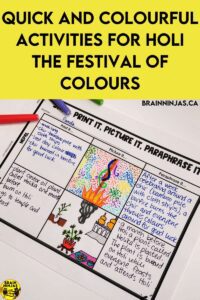
Learning about different traditions allows students to explore people and their cultures around the world. And it’s a cheap way to travel! We collected activities for Holi so you can travel with your students.
Holi is an ancient Hindu festival that originates and is widely celebrated in India. Although different regions of India have their own traditions and variations, they all share one thing, it’s so much fun! As people have moved around the world, settling in other countries such as Canada they have brought this celebration with them.
Many non-Hindu people around the world also celebrate Holi. In fact, this tradition has inspired all kinds of different events. It is often used to support all kinds of good causes, like children with chronic or life-threatening conditions and is incorporated into many different types of fundraisers.
Some Background on Holi
Holi is a spring festival that is based on the Vikram Samvat calendar. This means it falls sometime in February or March, depending on the phases of the moon. Celebrated for two days after a full moon, people across the country and around the world celebrate with many activities for Holi.
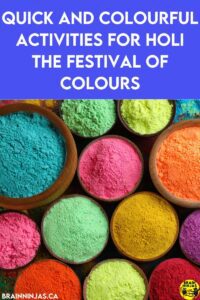
This festival is known for the tradition of throwing colourful powder or water. People fill the streets and spray each other while they sing and dance. And everyone is considered equal.
It’s more than just for fun. On the first day, people build giant bonfires to remember the importance of good winning over evil and how kindness and forgiveness are powerful.
As with most celebrations, there are stories and legends that explain the origin and reason for the traditions.
Some of these stories are graphic and, frankly, a little scary. (Have you ever read the original Little Red Riding Hood story?) How do we deal with this? We choose less gory versions or adapt them a little to make them more appropriate.
Stories and Legends About Holi
There are several stories related to Holi. The variations in stories are influenced by the regions of India they come from. Stories are great activities for Holi, and they are interesting too!
The Prince and Holika
The most common story is the one of King Hirnalasyapu, his sister Holika and the Prince because it explains the origin of the festival.
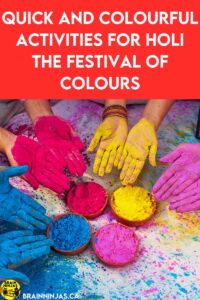
The King was egotistical and wanted everyone in the kingdom to worship him alone and none of the other Hindu gods. He ruled with fear, but his son, Prince Prahlad, gently refused to worship him. This infuriated the King and he devised all kinds of plans to kill his son in revenge, to no avail!
Eventually, the King convinced his sister, Holika, to help him. They devised a plan where she would convince the Prince to join her under her magic, fire-proof, colourful cloak in a bonfire.
The Prince agreed.
While they were sitting in the bonfire, her cloak fell away and covered the Prince, saving him. While she burned, she asked for his forgiveness for her ruse. As he was a kind Prince, he forgave her as she died.
He proclaimed the celebration of Holi as a day to remind people to forgive each other.
Shiva, Kamadeva and the Goddess Parvati
In a land far away in Southern India, there lived Shiva, Parvati and Kamadeva. The Goddess Parvati was in love with Shiva. She asked the god of love, Kamadeva, to shoot one of his love arrows at Shiva. Kamadeva did so, but Shiva became mad and burned Kamadeva to ashes. Kamadeva’s wife begged Shiva to bring her husband back to life. Shiva decided to grant the wish because of their strong love.
So Holi remembers this story and celebrates the act of love and forgiveness.
Krishna and Radha
In a land far away in Northern India, there lived the God Krishna. Krishna was famous for his love of mischief and playing tricks. Krishna played tricks on everyone and thought the tricks were very funny. One day he soaked his wife Radha and her friends with coloured water. They retaliated.
People play jokes on each other at this time of year in memory of Krishna, the joker.
This story explains why colourful powder and water are thrown in the air and at each other during this festival.
Krishna The Fair
Krishna loved Radha, his wife, very much. He worried about Radha having different coloured skin than him (he is often portrayed as blueish). His mother suggested that he rub coloured powder on her face so that she would be colourful too. So he did. And Radha did the same to him.
Explore Activities for Holi
Reading and Writing
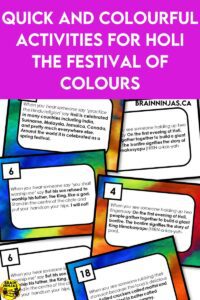
Want to explore Holi further with your students? Our reading and writing activities for Holi are designed for students in grades 3-6. It teaches the history and traditions of Holi through the reading of non-fiction texts.
It features the reading strategy 3Ps – Print it, Picture it, Paraphrase it. In this strategy, students write the information directly from the text (word-for-word notes) and Print it. Using the information they draw a picture that represents what they learned to Picture it. Based on the picture, students rewrite the facts in their own words and Paraphrase it. This strategy helps students learn to take information from books or websites and put it into their own words.
There are multiple versions of the 3Ps to support the different skill levels of your students. Skip doing the work yourself by grabbing Reading and Writing Activities for Holi. Find it in our TpT Store ($USD) or BN Shop ($CAN).
Writing Prompts
We created a simple set of writing prompts that can be used to write about the Holi Festival of Colours. Each of the ten days includes three choices to write about, but students do not need any background knowledge for all the prompts. There is always something to write about, and they can be done with paper or using Google Slides. Find the Holi Festival Of Colour Writing Prompts in our Tpt Store ($USD) or our BN Shop ($CAN). To learn more, check out this blog post, Challenge Your Students with Writing Activities Every Day.
Drama Circles
We use drama circles to teach all kinds of things. Learn more in our post How to Add Some Drama to Your Classroom. One of our favourites is this drama circle about the Holi Festival of Colours. You can find the Holi Festival of Colours Drama Circle in our TpT Store ($USD) or our BN Shop ($CAN).
Craft Ideas for Holi
Crafts are the perfect activities for Holi because they allow students to explore colour. We have a lesson in our Resource Library, or we can send it to you by email. Use these crafts to make a display or bulletin board about Holi.
Are you avoiding these types of activities because of the mess? You should read our post: Are You Avoiding Teaching Art?
Blow Painting
Add drops of paint on a paper and using a straw students blow on the drops of paint so that they splatter.
Snow Painting
Mix water and food colouring in spray bottles. Find a spot outside that has snow that has not been trampled and paint the snow. This one only works in winter climates.
Cornstarch Painting
Create a simple paint using one part cornstarch and one part water. Add a few drops of food colouring and mix well. This paint covers asphalt nicely and dries like brightly coloured chalk. As it’s made with food colouring that can stain, we don’t recommend it for porous surfaces or skin (it stains).
Elephants of Jaipur
Using an outline of an elephant (best to print on card stock or construction paper), have students decorate an elephant. Using crafting items found easily at your local dollar store such as ribbon, stick-on jewels etc., decorate the elephant to represent the Holi tradition in Jaipur, India of decorating elephants and parading in the streets during festivities.
Pictures of these decorated elephants can be found by searching Jaipur Elephants online.
We have included templates in a copy of this lesson with detailed instructions in our Resource Library, or we can send it to you by email when you join our mailing list.
Colour Throwing
Well, maybe it’s not quite throwing colour, but it does seem just as messy. Using a drawing of students, splatter paint over the drawings to symbolize the throwing of colour.
Get a copy of this lesson with detailed instructions in our Resource Library or we can send it to you by email when you join our mailing list.
Coffee Filter People
This one is much less messy but takes a day to dry. Give each student a coffee filter which they colour with water-soluble markers. Place the filters flat on a waterproof surface that won’t stain (or doesn’t matter if it stains). We use a plastic tablecloth. Spray the filters lightly with a mist of water. This will cause the marker to bleed. Let them dry.
Students can cut out a figure of a person and add personal details using a pencil (as it doesn’t spread or bleed on the filter).
The filters also make for nice decorations around your display, so cut out circles from the leftovers or make a few extras.
Holi Collaborative Poster
We created a collaborative poster that you can use to celebrate with your students. It comes with 18. 24. or 36 pieces. Students colour their own pieces and then they are assembled into a poster. It also comes with follow-up activities to learn more. Find the Holi Collaborative Poster in our TpT Store or BN Shop.
Books About Holi
Although there are fewer books on Holi than other celebrations, we managed to find a selection of picture books and non-fiction books that you can read with your class (even older students like a good picture book -although they won’t admit it out loud). You can also use the books to do further research. Books are easy activities for Holi because students can read and even write their own stories.
Stories for Holi
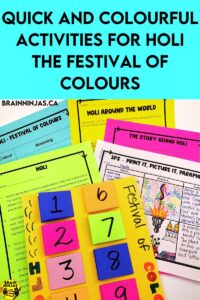
Here Comes Holi: The Festival of Colors by Meenal Atul Pandya
This story within a story is about the origins of Holi. A mother tells her child and their friends the tale behind this wonderful festival. Just a quick reminder…this story can be a little graphic.
Festival of Colors by Kabir Sehgal
This picture book tells the story of two siblings, Mintoo and Chintoo as they gather flowers to make the colourful powders that are used during the festivities of Holi. It culminates in a gathering of family and friends, reminding readers that Holi is a time to celebrate friendship, forgiveness and fun!
Why Do We Celebrate Holi by Anitha Rathod
Preeti learns the story behind Holi from her grandmother and celebrates the festival with her friends and family. The title is a great jumping-off point for a great discussion with your class. Why do we celebrate __________? What does it mean to have celebrations?
We Throw Color on Each Other! by Kavita G. Sahai
This tells the story of a brother and sister celebrating Holi while teaching the colours in Hindi.
Holi Colors by Rina Singh
This concept book shares the traditions of Holi through simple rhymes and colourful photographs. This book is very simple but could be a good model for kids to use to make their own version.
Holi, Festival of Colors (Shalu) by Nick Sharma
Follow the story of Shalu and Preeya, who discover that even when you are different you can still be friends as they take part in Holi festivities. This story explores friendship and differences.
Non-Fiction Reads for Holi
Amma, Tell Me About Holi by Bhakti Mathur
This book is written in rhyme and tells the story of the origins of Holi. The images are colourful, just like the festival itself.
Happy Holi: The Festival of Colour by Joyce Bentley
This book explores how Holi is celebrated by people around the world. It explains the history, preparations made for the festival and the celebrations through the use of beautiful photos.
Let’s Celebrate Holi! by Ajanta Chakraborty and Vivek Kumar
Learn about the history, food, language and traditions of Holi through this adventure as Maya, Neel and Chintu (their pet squirrel) visit their cousin Ameya in India. Who doesn’t like a story that has a pet squirrel?
Holi by Lynn Peppas
This is a simple introduction to Holi with vivid photographs. The use of captions throughout this book would be great to teach students about how to get information in a non-fiction book that is not actually in the text.
Holi by Rebecca Pettiford
This early reader introduces Holi and the ways people celebrate it. It includes a picture glossary and index. This simple book gives very general information for those students who are learning English.
Holi by Grace Jones
Learn about the history and traditions in this book that is part of the series Festivals Around the World. Get your hands on the whole series and you can have students research similarities and differences.
Holi by Michelle Lee
This non-fiction book informs students about the history and traditions of Holi.
Holi by Lydia Lukidis
This book is part of the series, Canadian Celebrations, and focuses on how people in Canada celebrate Holi. It’s a great way to explore how traditions move countries and are celebrated in our own backyards.
Looking for More Books?
If you are looking for some books for other holidays and observances, you might be interested in some of our other book lists.
Books for holidays and observances:
- Orange Shirt Day
- Remembrance Day
- Lunar New Year
- Ramadan
- Cozy Up with Winter Books
- Christmas Books We Love
- Black History Month
- Books With Great LGTBQ+ Characters
- Earth Day
- Thanksgiving
- Books for and About Powerful Women
- Books by Indigenous Authors
These books can be used any time of year:
Do you know about a book we should know about? Please help us expand our library by adding a book title to the comments below.







